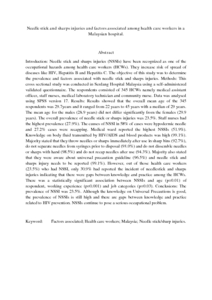Citation
Gyanchand Rampal, Lekhraj Rampal and Zakaria, Rosidah and Leong, Whye Sook and Md. Zain, Azhar
(2010)
Needle stick and sharps injuries and factors associated among health care workers in a Malaysian hospital.
European Journal of Social Sciences, 13 (3).
pp. 354-362.
ISSN ESSN: 1450-2267
Abstract
Introduction:
Needle stick and sharps injuries (NSSIs) have been recognized as one of the occupational hazards among health care workers (HCWs). They increase risk of spread of diseases like HIV, Hepatitis B and Hepatitis C. The objective of this study was to determine the prevalence and factors associated with needle stick and sharps injuries.
Methods:
This cross sectional study was conducted in Serdang Hospital Malaysia using a self-administered validated questionnaire. The respondents consisted of 345 HCWs namely medical assistant officer, staff nurses, medical laboratory technician and community nurse. Data was analysed using SPSS version 17.
Results:
Results showed that the overall mean age of the 345 respondents was 29.7years and it ranged from 22 years to 45 years with a median of 29 years. The mean age for the males (28.9 years) did not differ significantly from the females (29.9 years). The overall prevalence of needle stick or sharps injuries was 23.5%. Staff nurses had the highest prevalence (27.9%). The causes of NSSI in 58% of cases were hypodermic needle and 27.2% cases were recapping. Medical ward reported the highest NSSIs (51.9%). Knowledge on body fluid transmitted by HIV/AIDS and blood products was high (99.1%). Majority stated that they throw needles or sharps immediately after use in sharp bins (92.7%), do not separate needles from syringes prior to disposal (98.0%) and do not dissemble needles or sharps with hand (98.5%) and do not recap needles after use (94.3%). Majority also stated that they were aware about universal precaution guideline (96.5%) and needle stick and sharps injury needs to be reported (99.1%). However, out of those health care workers (23.5%) who had NSSI, only 30.9% had reported the incident of needlestick and sharps injuries indicating that there were gaps between knowledge and practice among the HCWs. There was a statistically significant association between NSSIs and age (p=0.01) of respondent, working experience (p=0.001) and job categories (p=0.03).
Conclusions:
The prevalence of NSSI was 23.5%. Although the knowledge on Universal Precautions is good, the prevalence of NSSIs is still high and there are gaps between knowledge and practice related to HIV prevention. NSSIs continue to pose a serious occupational problem.
Download File
![[img]](http://psasir.upm.edu.my/15786/1.hassmallThumbnailVersion/Needle%20stick%20and%20sharps%20injuries%20and%20factors%20associated%20among%20health%20care%20workers%20in%20a%20Malaysian%20hospital.pdf)  Preview |
|
PDF (Abstract)
Needle stick and sharps injuries and factors associated among health care workers in a Malaysian hospital.pdf
Download (86kB)
| Preview
|
|
Additional Metadata
| Item Type: |
Article
|
| Subject: |
Needlestick injuries - Malaysia. |
| Subject: |
Needlestick Injuries - prevention & control. |
| Subject: |
Public health personnel - Malaysia - Wounds and injuries. |
| Divisions: |
Faculty of Medicine and Health Science |
| Publisher: |
EuroJournals. |
| Keywords: |
Factors associated; Health care workers; Malaysia; Needle stick/sharp injuries. |
| Depositing User: |
Raja Norazlinda Raja Azenam
|
| Date Deposited: |
24 Jun 2013 02:07 |
| Last Modified: |
27 Nov 2015 03:11 |
| URI: |
http://psasir.upm.edu.my/id/eprint/15786 |
| Statistic Details: |
View Download Statistic |
Actions (login required)
 |
View Item |

